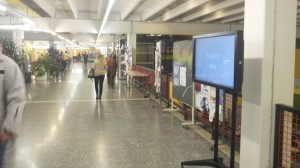At Ubicomp 2013 we presented one of the first papers to use public displays as a crowdsourcing platform. The paper was featured in New Scientist.
 This study was the first attempt to investigate altruistic use of interactive public displays in natural usage settings as a crowdsourcing mechanism. We tested a non-paid crowdsourcing service on public displays with eight different motivation settings and analysed users’ behavioural patterns and crowdsourcing performance (e.g., accuracy, time spent, tasks completed). The results show that altruistic use, such as for crowdsourcing, is feasible on public displays, and through the controlled use of motivational design and validation check mechanisms, performance can be improved. The results shed insights on three research challenges in the field:
This study was the first attempt to investigate altruistic use of interactive public displays in natural usage settings as a crowdsourcing mechanism. We tested a non-paid crowdsourcing service on public displays with eight different motivation settings and analysed users’ behavioural patterns and crowdsourcing performance (e.g., accuracy, time spent, tasks completed). The results show that altruistic use, such as for crowdsourcing, is feasible on public displays, and through the controlled use of motivational design and validation check mechanisms, performance can be improved. The results shed insights on three research challenges in the field:
- how does crowdsourcing performance on public displays compare to that of online crowdsourcing,
- how to improve the quality of feedback collected from public displays which tends to be noisy, and
- identify users’ behavioural patterns towards crowdsourcing on public displays in natural usage settings.
We are currently exploring alternative crowdsourcing tasks that can perform well on public displays including labeling tasks and other simple/fast tasks that can potentially tap into local knowledge. At the same time we are exploring other motivational approaches for this type of ubiquitous crowdsourcing like gamification or the use of virtual currency.
Publications
[bibtex key=Goncalves:2013:CSA:2493432.2493481]

